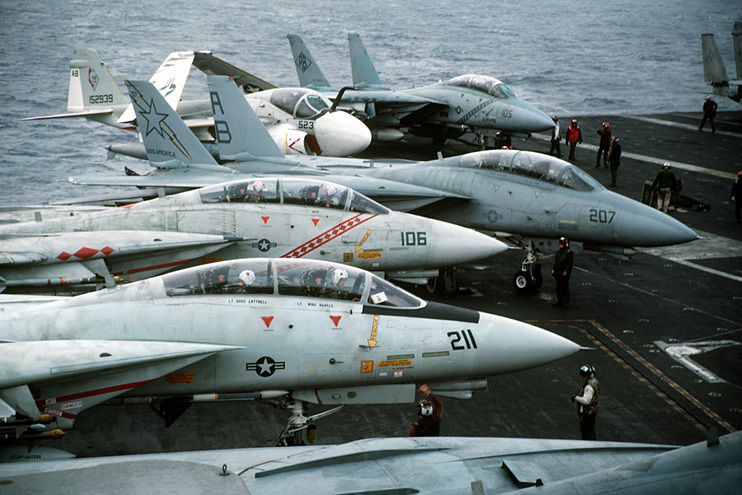In response, the U.S.A. decided to give 'ole Gadaffi a taste of his own medicine. Or, at least to try and put a damper on Libya's brand of state-sanctioned terrorism. And so, on April 15th, 1986, during a strike called 'Operation Eldorado Canyon', aircraft of the USAF, USN, and USMC attacked targets in Benghazi and Tripoli...most of which were believed to be related to Libya's terrorist activities.
The ball started rolling on April 14th when 24 General Dynamics F-111F Aardvarks of the 48th Tactical Fighter Wing departed RAF Lakenheath in the UK late that evening. They were joined by four or five General Dynamics/Grumman EF-111A Ravens from the 42nd Electronic Combat Squadron, flying from RAF Upper Heyford, which would provide jamming support during the raid. The designated targets for the F-111s were Tripoli Airfield, Bab al-Azizia barracks, and the Murat Sidi Bilal terrorist training camp.
The following seven photos show the F-111Fs prior to and during departure for the raid...
All above photos, SSgt. Woodward, USAF
As Spain and France refused to allow overflight of their airspace, the F-111s had to take the long way 'round, passing over the Atlantic Ocean, around Spain, through the Straits of Gibralter, and then into the Mediterranean Sea. They were supported by more than forty USAF tankers, refueling three times en route to Libya... twice over the Atlantic and again as they approached the Mediterranean. Of the force of 24 F-111Fs, six were spares which would take the place of any others that might have to abort for whatever reason. Apparently the spares were not needed and returned to the UK at some point between the second and third refuelings.
This painting by Ronald Wong depicts an F-111F destroying Il-76 transport aircraft at Tripoli Airfield.
And a look at the real deal, as seen through an F-111's Pave Tack targeting system...
Also participating in the strike were several types of USN and USMC aircraft, operating from the aircraft carriers USS America (CV-66), USS Saratoga (CV-60), and USS Coral Sea (CV-43) which were all on station in the Gulf of Sidra off the coast of Libya. Grumman A-6E Intruders would attack Benina Airfield, and Jamahiriyah barracks near Benghazi, while LTV A-7E Corsair IIs, and McDonnell Douglas F/A-18A Hornets would perform air defense suppression at Tripoli and Benghazi, respectively. (This was the combat debut for the-then brand-new F/A-18.) Electronic warfare support was provided by Grumman EA-6B Prowlers. Combat air patrols were flown by Grumman F-14A Tomcats and F/A-18s, in case the Libyans managed to get any interceptors airborne, and the whole dang thang was watched over by the Navy's eyes and ears in the air, the Grumman E-2C Hawkeye air early warning aircraft.
This photo shows several jets launching from USS America during the operation... an F-14A from VF-102 'Diamondbacks' in the foreground, an A-7E from VA-46 'Clansmen' and an EA-6B from VMAQ-2 'Playboys', a USMC outfit. To the left, an F-14A from VF-33 'Tarsiers' (The modex '201' on the nose indicates that this is VF-33's 'boss bird', assigned to the squadron CO.) and an A-7E from VA-72 'Blue Hawks'.
US Navy Photo
Though taken two days after 'Eldorado Canyon', this A-7E of VA-72, carrying Mk.20 Rockeye IIs and AGM-45 Shrikes, is representative of the A-7s which provided air defense suppression during the raid.
US Navy Photo (PHAN David Casper, USN, photographer)
This photo shows several F-14s from VF-102 and VF-33, with a single A-6 Intruder aboard USS America, and was apparently taken in the hours prior to launch for 'Eldorado Canyon'.
US Navy Photo
As with any such undertaking, there were risks... and, sadly, one F-111F was lost with her crew. F-111F 70-2389, callsign 'Karma 52' is believed to have been hit by a SAM (surface to air missile) or AAA (anti-aircraft artillery) and gone down in the water while inbound to its target.
'Karma 52' was crewed by Capt. Fernando Ribas-Dominicci and Weapon Systems Officer Capt. Paul Lorence.
USAF
F-111F 70-2389
USAF photo via F111.net
Aside from the loss of the F-111 crew, the operation was largely successful in accomplishing its tactical objectives... though some ordnance did fall off-target and, regrettably, some civilian casualties were incurred. However, a greater objective was accomplished without question... and that was to show the world that those who would commit acts of terror would most definitely be held to account.
Unfortunately those who would commit such acts didn't quite get the message, and acts of terrorism are still taking place to this day. But your blogmeister rests somewhat easily at night because we still have those who, like the men of 'Eldorado Canyon', stand ready in the night to visit violence on those who would do us harm.
------------------------------------------------------------------------------------------
The above is a very general and incomplete description of 'Eldorado Canyon'. Your blogmeister could have written more, but he likes to keep things fairly brief more often than not. If you're interested in learning more about 'Eldorado Canyon', there's a good bit out there on the net. However THIS webpage contains by far the most detailed account we've come across.
Fade to Black...

















b.jpg)


